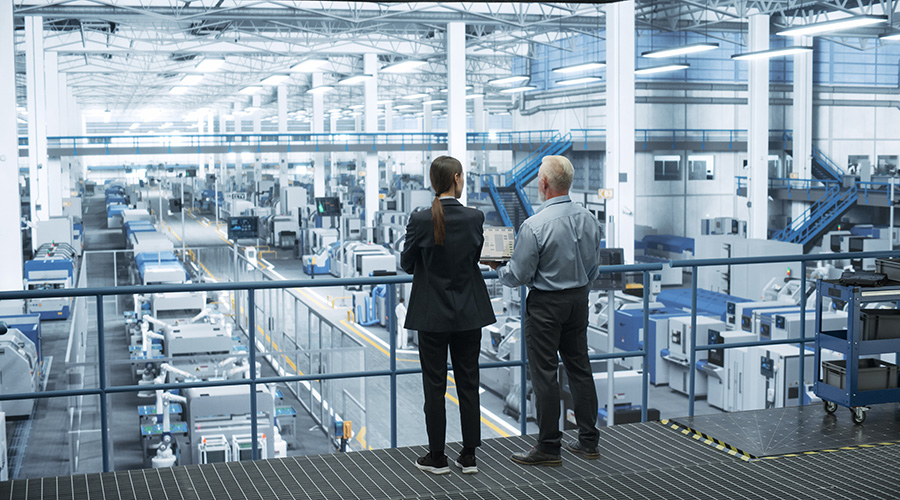Managers Discuss Their Role in LEED Certification
By Chris Matt, Managing Editor - Print & E-Media
OTHER PARTS OF THIS ARTICLEPt. 1: This Page
*Mark Bettin, Vice President of Engineering, Merchandise
Mart Properties Inc., Chicago
*Michael Burson, Director of Planning and Construction,
Cincinnati Public Schools
*Paul Butapetch, Engineer, University of California,
Los Angeles (UCLA) Facilities Management – Energy Services & Utilities
Few initiatives have had as big an impact on facilities management as the U.S. Green Building Council's (USGBC) rating system, Leadership in Energy and Environmental Design (LEED). Many managers are planning to undertake a LEED project, while others are simply learning about the rating system's impact on maintenance and engineering departments in commercial and institutional facilities. Three facility professionals who have spearheaded successful certification efforts offer insights and discuss strategies.
Question: What was your role on the LEED-certification team?
BURSON: I'm the district's chief representative to the project. When we started (the district's modernization program), I was responsible for both the master plan and maintenance and operations. Because I have been a facility manager for almost 30 years, I hope that we have that (maintenance and operations) perspective. We're all located in the same building, and we spend a lot of time together. The architects are able to interact with our maintenance and operations folks, as well.
BUTAPETCH: Technically, my role was LEED project administrator, but since UCLA wasn't set up to handle the requirements of LEED, I had to put on many other hats. I performed the majority of the data gathering required for all the achieved credits and prerequisites. I drafted and aided in the development of policies required for the LEED credits and prerequisites, as well. Typically, most of the programs, like recycling and equipment management, were being performed as a part of business as usual, and policies didn't exist in a format readily conveyed to the USGBC. A large portion of the work is to gather all the relevant LEED data and repackage it into a format that the USGBC wants and accepts.
BETTIN: My role was to manage the certification process, as well as department supervisors and consultants we had on the project during the certification process. We were meeting on a weekly basis to go over the status and review each credit. There's not really one operations supervisor. There is a whole team of people here that go into operating the facility.
Question: What were the first steps you took in tackling certification?
BUTAPETCH: The first step, like any other LEED project, was to establish a baseline. The School of Public Affairs (Building) was a problem because it was a state-funded, 50-year-old building with little to no historical data on utility use and minimal metering. (It) is connected to the campus distribution loop for chilled water, steam, domestic water, and electricity, and being 50-plus years old, it has gone through many infrastructure renovations. This made it a nightmare to fully meter the building's utilities.
BETTIN: We had to engage with the consultant right from the get-go. They reviewed how we were operating the facility and how the procedures fit into the certification. From the outcome of that analysis, we could build on our efforts in housekeeping, recycling, and materials management. We had some solid programs going on there that dated back into the early 1990s. The bottom line with it is, there were plenty of good things that were going on here that helped us in launching the whole (LEED) process.
BURSON: The engineers, along with all impacted staff and the project manager with the state of Ohio, will sit around the table and go down the LEED checklist and do an assessment of our ability to capture a point. It's a pretty exhaustive process we go through on every one of our projects.
Question: Why did your organization decide to pursue LEED certification?
BURSON: Before we started this (modernization effort), we hadn't built anything (new) since 1982. Energy conservation is a real challenge for us.
BETTIN: The first LEED meeting was back in 2000. From a LEED-Commercial Interiors (CI) track, we had a tenant that went through the pilot for that back in 2005. So, if you get right to the core of operating a facility and working with a tenant that wants to do things differently or more rigorous (in terms of environmental responsibility), we went through it point by point at that stage. That was definitely one of the building blocks. Today, there are over 12 projects (in The Merchandise Mart) that are now LEED-CI.
BUTAPETCH: As a commitment to stewardship of the environment and to reduce the university's dependence on non-renewable energy sources, the University of California established policies on green building design, clean-energy standards, and sustainable practices. As a result of these policies, each university is required to certify one building to LEED for Existing Buildings (EB) standards as a pilot. LEED-EB was intended to be used as a tool to explore, develop, and address aspects of building cleaning, maintenance, and operation to include factors such as chemical usage, indoor air quality, utilities, and recycling programs.
Question: What were the project's biggest challenges?
BUTAPETCH: The biggest challenge would be the documentation load. We're not set up to report the way USGBC wants it. A lot of work had to be done documenting our practices and turning that into policy, instead of the other way around Ð developing a policy and doing our practices based on that. We weren't separately funded for this project, so everyone who helped me helped me on their free time, on the side.
BURSON: Maintaining the appearance of the (historic Rothenberg School) building from the exterior is something that is foremost in everybody's mind. On the inside, it's a challenge when you take a building like that with (older) masonry, very large windows, and 13-foot ceilings. We are working on an innovative system to use geothermal (heating and cooling). We're going to find a way to put in geothermal wells and use that to heat and cool that building.
BETTIN: One of the biggest challenges Ð and it still is today Ð is raising awareness for the staff, as well as the tenants, on how we're operating the facility and how we expect staff and others to hold up their end of the bargain. With retirements and people moving on, you're always training and re-emphasizing what we like to achieve here.
Question: What were the biggest lessons you learned during the project?
BETTIN: When you're surveying tenants and surveying staff, doing that upfront is important. We did it well into the project. It was halfway through the project by the time we engaged more of the tenants in the certification process. The tenant survey is definitely a lesson learned. We also expanded the certification to include the whole company. Initially, it was more operations-based. When it was all said and done, it was just about every department that works here at The Merchandise Mart.
BURSON: The beauty of what we're doing is, every Thursday, we have 10 architects come in here for 45 minutes a piece. We're building a lot of synergy between the different projects. Rothenberg is being influenced by the (projects) that are just a little bit ahead of it in the process. Just (recently), we had a discussion and concluded that we were going to apply insulation to the exterior wall of Rothenberg. The architect was a little reluctant in thinking that we were adding a lot of cost. But they came in with energy models to show how much savings we would generate by doing that. Those are some of the little tricks we picked up now. It really is a great time because we are working on so many projects at one time that ideas are cross-germinating.
BUTAPETCH: I think other campuses are asking for more student involvement, which makes sense because a lot of the tasks require volunteer work, a lot of data gathering, a lot of things students can help out with. We also probably would want to get more involvement from the building occupants. We were essentially telling them what we were doing and why we're doing it, but we didn't really involve them in the whole process.
Question: How will you monitor building energy use post-certification?
BURSON: Some of the things we're doing with interest-free bonds that have been available through the stimulus program is, we're going back (to the completed projects) to establish a bridging building-automation system. We do have five or six different manufacturers of building-automation systems. We want to set up a bridging system that allows us to be able to have better control over the entire system. Monitoring what we're doing is very important.
BUTAPETCH: It's definitely in our long-term plan. The long-term plan is to have everything on building-automation controls so our engineers can pull something up on screen and look at all their temperature set points, all their airflows, and anything that's required to optimize a building.
BETTIN: We're such a large facility, so you really have to start breaking things down. You need sub-metering to do that. We've also invested in temporary metering equipment, where you can move it from panel to panel, and you can look at three, four, five or six circuits at a time. You can look at what a retrofit has done relative to (energy savings). My recommendation to folks who aren't going to have permanent metering left in place would be to find some way to put temporary metering in as part of the project to help yourself with (determining) the baseline.
Related Topics:











